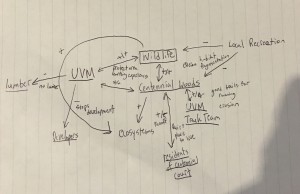There has been very little change to my site since I last visited it. This winter has been a lot more mild than previous ones, which could attribute to the lack of change. I have noticed that there are less birds in the area, as they have possibly migrated for the winter. Now the trees have full shed their leaves, somewhat obstructing the flow of the river. I have also noticed that there has been less human activity in the area, as my own footprints have been the only fresh ones as far as I can tell. This could be attributed to the coming winter.
Archive for December, 2015
9 Dec
History of My Site
The area my site is located in, Centennial Woods, has a very rich history. The oldest known evidence of human interaction at my site was that of Native Americans over four thousand years ago. An area in Centennial Woods contained evidence of Native American tool making, including stone flakes. This evidence was found by students in UVM’s archaeology program in 1998. From this point forward, the site was used by Native Americans up until the seventeenth century, when settlers from other countries came to settle the land. This marked the point where the Natives shared the land with the settlers, who eventually built the area up into the modern day Burlington we know.
7 Dec
Social-Ecological System Map
When creating a Social-Ecological System Map for my site, I noticed that my site is affected and affects several groups, in both positive and negative ways. The site in Centennial woods is beneficial for the wildlife living their, providing them with a habitat. Centennial Woods also provides a place for the students at UVM to learn about the natural world in a hands on manner. In turn, UVM protects Centennial Woods from threats like the lumber industry and would be developers. The wildlife and Centennial Woods contribute to the natural ecosystems found in the area. Centennial Woods is unfortunately negatively affected by local recreation. The constant stream of hikers and runners lead to habitat fragmentation and erosion, damaging the ecosystems in the area. Centennial Woods benefits the people living at Centennial Court as well. Since there are no other houses around, due to the protection of the land provided by UVM, they can enjoy a safe and quiet neighborhood. Unfortunately, the people living there and the developed areas so close to the forest can create harmful runoff that could damage the ecosystem. Overall, Centennial Woods is an area that provides many benefits to the communities in the area, and even though there are minor drawbacks, the bulk of the would be problems are negated by the protection UVM provides.
1 Dec
Phenology vs Home Site
My spot at home is a large rock on my property. It is in a deciduous forest, with many tree species comparable to my phenology site, including Northern Red Oaks, White Oaks, Red Maples, and Sugar Maples. The site also has tree species that are different from my site, mainly Mountain Laurels. This similarity is due to the fact that my home is in relatively the same climate zone as Vermont, so therefore, there is a similarity in the species found in these two areas. The similarities do not stop at plant species, however. I have noticed that both of my sites share the same types of animal species. This includes Gray Squirrels, White Tailed Deer, and Chipmunks. In addition to these species, I have seen similar bird species, including Pileated and Downy Woodpeckers. My home site has other bird species in it as well that are not found at my phenology site, to the best of my knowledge. These species include Blue Jays and Cardinals. My home site is at a much higher elevation compared to the surrounding area than my phenology site, and there is therefore a lot less soil due to erosion. This has not had any noticeable impact on the species found in my site, however.



Recent Comments